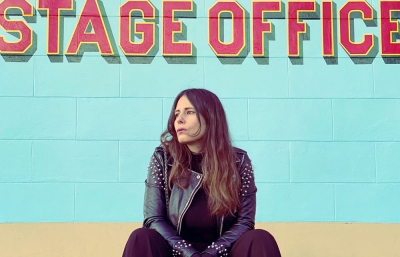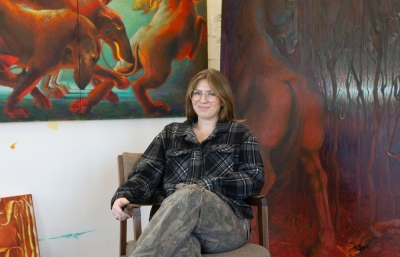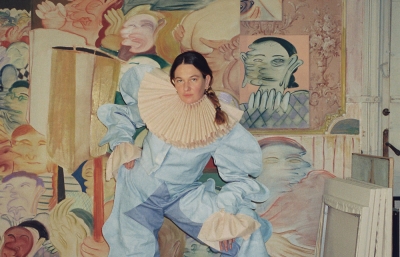Tiffany Alfonseca
A Not So Subtle Rebellion
Text by Jewels Dodson // Portrait by the artist
With a population of a little more than 200,000, Washington Heights is 1.7 square miles sitting at the north end of Manhattan. It was first settled by Irish immigrants, and by the mid-twentieth century, became the largest US refugee settlement of German Jews fleeing Nazi Germany. Today it is the American epicenter of Dominican culture. Imagine the aroma of deep fried chicharrón wafting through the sounds of classic merengue blaring from a bodega and reggaeton blasting from an apartment window. Street vendors are busy selling everything from suspicious M.A.C. lipsticks to pastelitos con queso y jamón as “Oye primo” resounds from all corners. A cacophony of Spanish ricochets louder and faster than a Pedro Martinez fastball. Unlike other heavily gentrified ’hoods in New York City, la gente have kept the soul of this community intact. So, on a snowy December afternoon in her South Bronx studio, when artist Tiffany Alfonseca proudly proclaims, “I’m Dominican as fuck,” I know exactly what she means.
Dominican-American artist Tiffany Alfonseca is new to the contemporary art world, but she has always had an innate, special relationship with figures, drawing lines, colors, and shapes. “I’ve always been an artist. My earliest memory as a three-year-old was drawing mermaids and dolphins.” And unlike many immigrant parents who encourage their kids to get good stable jobs, Alfonseca found a real cheerleader in her mother, who now exults to friends and family, “Yo tengo una hija artista famosa.” “My mom loves the fact that I’m an artist. I could never see myself doing anything else.”

Alfonseca lived in the Gunhill section of the Bronx but spent most of her waking hours in the Washington Heights/Inwood section of Manhattan. “I grew up in the Inwood, 207th street area. I love that area. It’s like little DR, I feel like home there,” she says. The 26-year old is the younger of two sisters, her older sibling, a psychologist, and although their mother was born in the U.S., like many immigrant families, she adopted entrepreneurial skills and created several streams of income, owning two daycare centers and managing her own catering operation. “I was raised in a super Dominican household. Spanish is my first language. And in our house, there were lots of bright colors and fruits and plants all through the house. It all shows up in my work,” Alfonseca explains.
After attending Fashion Industries High School where she honed her drawing and illustration skills, but learned that fashion was not her medium, Alfonseca eventually graduated from the School of Visual Arts. Like many artists of color, Alfonseca echoes a reoccurring narrative often expressed by attendees of storied arts education institutions, citing a Eurocentric curriculum that focuses on works, artists, and ideologies rooted in Western philosophies. Her frustration still fresh in mind, she recalls, “In that group, I was one of the only Spanish-speaking people. There were only, like, five people of color in my cohort. The feedback I was given on my work was that it’s ‘exotic.’ Why is that the response, because I’m Latina, I have to be exotic?”
This all-too-common reality at the university level is finally being re-examined with intensity at contemporary art museums and institutions, especially in the last year. The exclusion and erasure of anything outside the cis-gendered white male gaze is a systemic issue that often appears at the university level and proliferates into museum and gallery spaces. Artists and narratives that diverge from classical Eurocentric standards are perpetually excluded or forced to live in the margins. Silence runs the risk of stagnating the whole contemporary art discipline.

While the world was in tumult for 2020, Alfonseca experienced a growth spurt that catapulted her onto the collective radar of curators and collectors, quite the feat for a new artist with no gallery representation. “I get recommended by word of mouth, and people reach out to me everyday through Instagram,” she said. She attributes her expansion to a few things, such as initiating a drawing series during quarantine when she asked close friends to pose for her, in this case, images of themselves they sent to her. Enjoying the experience so much, she extended the invitation to her Instagram followers, and the project just took off! Inadvertently, Alfonseca had successfully executed the best kind of marketing strategy—without even trying!
She also saw more interest in her work during the height of the Black Lives Matter protests last summer, although, six months later, she notes that the outpouring of support has dwindled to almost nothing. “At that time, a lot of people were looking for artists of color, just to be on trend. It’s so bothersome to me. Once the protests settled down, the calls just stopped, almost completely. What happened to all the support? It all felt super trendy and very staged.”
Alfonseca is part of a growing number of artists who are concerned about making work that matters, as well as who buys the work, where it will live, and who gets to see it. For many artists of color, it’s a concern that their work gets fetishized. “At first, I wanted my art to be accessible to people of color, and I still stand by that. I need that because there’s limited access, and they get turned down [through galleries]. I’m at the beginning of my career, and it’s important that my work is accessible to everyday people. I also want buyers to have my work live in their homes and to have some kind of relationship with it. But it’s also important to have it in a museum or living somewhere where everyone can see it. My subjects and my work are my culture. If you can’t relate to my culture, or don’t have a greater understanding, especially when my work is in Spanish, there’s that thought in the back of my mind, ‘Why do you want this? What are you going to do with it?’”

All Alfonseca’s works feature subjects of the African diaspora, and in earlier pieces, she favored hues reminiscent of Kerry James Marshall. While she considers him a muse, her relationship to a maroon color palette also stems from another place. “A lot of my work is based off of my childhood memories in the Dominican Republic. I remember seeing paintings of people with dark skin, but made by Haitian artists rather than Dominican.”
This is a reference to the street vendors who lavish the streets of DR, selling painted canvases reminiscent of art works from neighboring Haiti’s masters, Philomé Obin and Hector Hyppolite. Their early twentieth-century pieces often depict scenes from Haitian culture and island life. Religious ceremonies, celebrations, the island’s abundance of plant life and produce, and subjects painted in rich shades of brown abound, like early Haitian artist Gabriel Alix’s Panthère, featuring a big-eyed, midnight blue panther surrounded by tropical melons, avocados, cacti, and gushing greenery. The self-taught godfather of modern Haitian art, Philomé Obin painted street scenes and expressed his visions of Haitian history. The ‘Obin Style’ is referred to as “magical pseudo-realism.” Works like his Paysans Sur la Route de Quartier Marine and Cap-Haitien Carnival capture island life with clear cerulean skies, towering palm trees, and cocoa colored black people, more multitudinous than monolithic narratives allow. The influence of these works is apparent in pieces like Alfonseca’s Natalie Matos and Si dios lo permite from her latest series.

On October 2, 1937, Dominican dictator Rafael Trujillo responded to reports of Haitians stealing cattle and crops from Dominicans in the northwestern borderland region of the country. He ordered his troops to kill all Haitians residing in the area. The massacre or el corte (the cutting) as it’s called by Dominicans and as kouto-a (the knife) by Haitians, lasted for six days, with armed Dominican forces killing Haitians with rifles, machetes, shovels, knives, and bayonets. Through a rich oral tradition, the horrific stories of this event have survived. Those who lived reported Haitian children tossed about and caught by soldiers' bayonets, then dumped on their mothers' corpses. Other accounts reported Haitian people strangled by soldiers, hacked with machetes, and children bashed against rocks and tree trunks. Several months later, more killings and expulsions of Haitians occurred in the southern border provinces. Due to a lack of documentation, historians estimate anywhere between 12,000 and 35,000 murders of Haitian people.
“El Jefe,” as Trujillo is known, made no secret of his disdain for Haitian people. He openly viewed Haitians as racially and culturally inferior, viewing their migration as a detriment to the social and economic development of the Dominican Republic. He is quoted in a speech:
“There is no feeling of humanity, nor political reason, nor any circumstantial convenience that can force us to look indifferently at the Haitian migration. That type is frankly undesirable. Of pure African race, they cannot represent for us any ethnic incentive. Not well nourished and worse dressed, they are weak, though very prolific due to their low living conditions. For that same reason, the Haitian that enters lives afflicted by numerous and capital vices and is necessarily affected by diseases and physiological deficiencies which are endemic at the lowest levels of that society.”

The accusations made against Haitians became the guise under which Trujillo began ethnic cleansing. Coupled with the mass genocide of Haitian people he also implemented a larger campaign to spread anti-Black rhetoric and sentiments, an effort to erase DR’s inextricable connection to Africa. Like many countries around the world with a history of European colonization, DR suffers from post-colonial effects of anti-Black ideologies, white superiority, colorism and self-loathing with a collective premium put on European ideals of light skin, light eyes, and straight hair. Trujillo’s reinforcement of Eurocentrism left an indelible imprint on Dominican culture.
In 2014, history repeated itself when the Dominican government changed its constitutional and immigration laws in response to an influx of Haitian immigrants. The Dominican government used Haiti’s calamitous 2010 earthquake as a reason to expel migrant Haitians and banish Dominicans born of Haitian descent, leaving them displaced and stateless, though many are lifelong residents of DR and have little relationship to Haiti. In DR today, persons of Haitian descent are highly discriminated against from the Dominican-majority police and government.
Alfonseca’s work sits at a dynamic intersection comprising Afro-Latinx identity, her relationship to the Dominican Republic, and her experience as a Dominican-American born and raised in New York City. Her work encompasses these perspectives and is laden with symbols and imagery that resonate with an ethnic demographic who exist but still don’t yet enjoy appreciation of their aesthetics, much less amplification of its voices. Her paintings feature subjects with melanated hues, African facial features, curvaceous body types, acknowledging, celebrating and honoring silenced cultures.
As Afro-Latin identity becomes more of a narrative in the contemporary art sphere, young Latin American artists of African descent are differentiating from the large homogeneous umbrella of Latin America. There is a more nuanced conversation emerging, challenging the monolithic lens of Latinidad. A singular lens is inaccurate as it silences people and important cultural accounts. What once served as a distilled unifying identity is now being repelled by Latinx who want to acknowledge the differences among the Latin American experience.

Cesar Garcia, Director of The Mistake Room, a non-profit art space in Los Angeles, discovered Alfonseca while organizing a Latinx art survey exhibition, and is currently organizing her first institutional solo show slated for the fall of 2021. He explains, “When Afro-Latinx work enters the art market, it immediately gets brought in through an African-American lens, and in the process, it removes Latinidad from their work, which is a really important dimension of their practice. For artists like Tiffany, whose life and work is deeply rooted in her relationship to her mother country and to Dominican-American heritage, not having that forefronted in her practice is dangerous. I am hoping that our solo exhibition with her is going to be an opportunity to begin having a very serious conversation about the harm we can do when we remove an incredibly important part of Afro-Latino artist’s identity.”
In the painting, Uh-Huh Honey, a nude, curvaceous brown-skinned woman sits, legs curled beneath her on an ocean blue bed, surrounded by emerald green plants and pink pastel walls, her 360 afro the perfect crown. She looks like Amara La Negra when the cameras aren’t rolling. At first glance, this woman could be perceived as African-American but in Alfonseca’s world, there is very little doubt this woman speaks Spanish and is the descendant of both colonizers and slaves. Garcia notes, “The subtleties in these domestic spaces, in her color palette, in the objects that appear in the work [which] speak to a black experience that is Latinx—that is what got me so excited about her work, that we were going to be able to have a conversation about those subtleties and about some of these challenges. What excites me the most is that there are these very genuine specificities in the work. I am interested in how she’s able to speak to these really important parts of who she is through subtleties in the work.”

This is also exemplified in Alfonseca’s painting, Iglesia, where she captures imagery of one of the primary pillars of the Latin female beautification experience—the hair salon. The title, which translates to “church” is apt because the hair salon in Dominican culture is a temple, a sacred space where women go to honor their treasured tresses. Underneath the blow dryer’s heat, the Dominican hair salon is a minefield riddled with hair shaming, respectability politics, and stubborn Eurocentric beauty standards that are unkind to kinky and coily Afro-Latinx hair textures. In this piece, Alfonseca focuses on the “blow out.” One woman is having her hair blown straight by another, both subject’s hair represented in gold glitter paint. The gold hair speaks to Alfonseca’s willingness to experiment with colors and textures, but also symbolizes the premium put on Latin women’s hair. Hair, for many Latinas, especially straight hair, is a form of currency that garners acceptance and attention.
Alfonseca’s work is a subtle rebellion where she honors African diasporic narratives by pushing back against centuries of colonialism. Her work provides a much needed pathway to healing. Afterall, straight hair and light skin are not pre-requisites for being seen and heard, nor are they requirements to be valued and celebrated.






